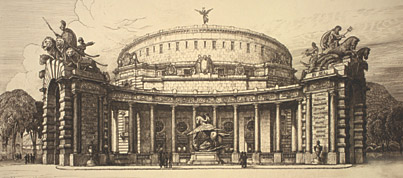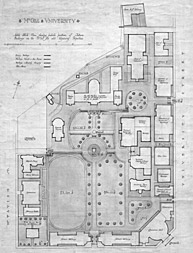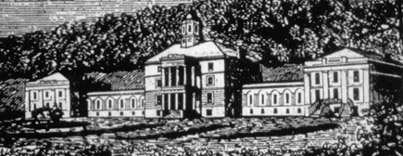The campus that never was
Images courtesy McGill Rare Books and Special Collections
Last year McGill held its convocation ceremonies in a giant tent on lower campus. But what if we had our own hall, purpose-built for such activities? It nearly happened, in 1919.
Students have always grumbled about the difficult walk up the steep slopes of University Street to reach the residences. Wouldn't it be convenient if the residences were on the lower campus? That, too, almost happened, in 1918.
And what if the Arts Building had a terrace above the current entrance, so people could step out and enjoy the view of the main avenue as it sweeps towards downtown? All part of the original design in 1839.
Over the years, different architects have put forward a variety of plans and proposals for McGill's lower campus, including a gym on Sherbrooke Street and an imposing tower in the Redpath Library. The News presents a small selection of big ideas from McGill's early days that never made it off the drawing board. Join us and former School of Architecture director Derek Drummond, BArch'62, as we tour an imaginary campus -- the McGill that might have been.
The forgotten memorial

During the First World War, even before the fighting had ended, the question arose at McGill as to how to best commemorate the students and staff who perished in the conflict. Architecture professor Percy Nobbs, whose work can be seen in many aspects of the campus today, believed he knew the answer: a convocation hall to seat 3,000 would be the most appropriate honour.
"While overseas, I have taken the opportunity of studying several halls of kindred purposes in Paris, London and in Edinburgh," wrote Nobbs in 1919. "This new solution of the requirements as decided upon results in a circular building with a monumental entrance colonnade flanked by triumphal arches. An opportunity is thus afforded to express in sculpture, decoration and inscription the triumph of our Arms by sea and by land."
The hall would have faced south on the corner of McTavish and Sherbrooke where the McLennan Library is today, on land "spiritedly acquired in 1909 to prevent the promoters of the Ritz-Carlton [hotel] scheme from exploiting the campus as a back yard."
In the end, the Board of Governors, although enthusiastic about the project, refused to provide funding, recommending that the Graduates' Society be asked to raise the money.
Nobbs's ill-fated design was dramatic to say the least, but Architecture professor Derek Drummond minces no words on the appropriateness of the monumental hall set amongst McGill's more modest Victorian structures. "It looks like a Beaux Arts student project. It doesn't look like Nobbs," he says. "The less said about it the better!"
A new campus plan
In the June 1920 issue of the McGill News, Nobbs laid out a history of McGill building projects to that date, and a number of the space challenges that needed to be met for the future. This built on an earlier plan he had drawn up for the University soon after his arrival in 1903.

Both plans, in the words of Nobbs's biographer Susan Wagg, "called for an orderly, symmetrical layout of the grounds relating to the main axes of the existing structures with future buildings occupying the perimeter."
Ultimately, this would have made the campus an enclosed and quiet precinct within Montreal's busy core. Drummond can only heave a sigh of relief that this was never done.
"Thank God they didn't do what Nobbs suggested," says Drummond. "That's dramatically different from what we have now. It would have made it a cloistered English university."
Drummond also notes a certain vanity in Nobbs's design. The main vehicular entrance to the campus would have been to the east of the current Roddick Gates, directly across from the McCord Museum, originally the Student Union building and the first structure Nobbs designed for McGill.
"He put the main entrance across from his own building. What a pompous thing to do!"
Arts Building

McGill's early years were not easy ones. Although incorporated in 1821, the University didn't begin construction until 1839. The Arts Building is McGill's oldest structure, built when the University was struggling financially. When the building was completed, the University consisted of the Principal (William Dawson), one professor and three students, two of whom were Dawson's nephews.
The University architect was John Ostell, who designed the central and east wings of the current Arts Building. He also designed the original campus layout, with a number of ornamental and kitchen gardens and the central lane. Derek Drummond says that it was Ostell's idea to keep the campus open to the city.
Financial constraints had an effect on the initial construction. A third floor was added to the central and east wings, while the west wing would not be built until the 1860s. The famous cupola was added to the plans mid-construction, while the halls connecting the central and east wings would have to wait for wealthier days.
In Ostell's original plans, the portico was to be two storeys tall, supported by Doric columns, with a small patio on the second floor leading to the library on that floor. Cost killed the idea -- when the building was completed in 1843, the portico was a temporary wooden structure.
"In plan it's more or less how it ended up," says Drummond, although he points out that the current east and west wings (Molson and Dawson Halls) are not symmetrical, as Ostell envisioned.
"The original wouldn't have altered the plan of campus at all, but it's not nearly as interesting as the current building."


